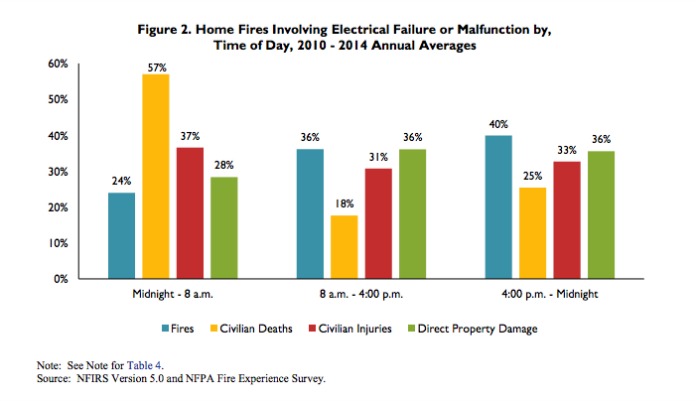Every year, 1,370 people are injured and 420 die in fires that started from electrical failure or malfunction. To increase awareness about the reducing the risk of electrical fires, the National Fire Protection (NFPA) has released a report about and compiled these safety tips for Electrical Safety Month.
When Do Most Electrical Fires Happen?
About 40 percent of electrical fires, injuries and fatalities occur during the cold-weather months from November through February and the month of July, according to the study of electrical fires occurring nationwide between 2010 and 2014, January is the peak risk month with 11 percent of fires and 17 percent of fatalities. The fires were distributed fairly evenly on each of the days of the week.
 Although the fewest number of fires occurred from midnight to 8 a.m. (24 percent) most electrical fire deaths (57 percent) and injuries (37 percent) occurred during that time. Most fires occurred between 4 p.m. and midnight, when 33 percent of injuries and 25 percent of electrical fire deaths occurred. The fewest number of injuries (31 percent) and deaths (18 percent) occurred between 8 a.m. and 4 p.m.
Although the fewest number of fires occurred from midnight to 8 a.m. (24 percent) most electrical fire deaths (57 percent) and injuries (37 percent) occurred during that time. Most fires occurred between 4 p.m. and midnight, when 33 percent of injuries and 25 percent of electrical fire deaths occurred. The fewest number of injuries (31 percent) and deaths (18 percent) occurred between 8 a.m. and 4 p.m.
Sleeping or Trying to Escape
Most fatalities occurred when people were sleeping (42 percent) or trying to escape (41 percent). Six percent of people who died in electrical fires were unable to act.
How Do These Fires Start?
Investigators were able to determine the specific source of a malfunction in about 50 percent of the electrical fires that occurred between 2010 and 2014, according to the report. Unspecified arcing accounted for about 25 percent of the fires, 11 percent were attributed to short circuit from old or defective insulation, 6 percent from an arc or spark from operating equipment and 5 percent from a faulty contact or broken conductor.
Appliances and Equipment Involved
Most electrical fires (57 percent) were associated electrical distribution, lighting, and power transfer equipment. Heating, ventilation and air conditioning equipment accounted for 19 percent, followed by kitchen and cooking equipment at 9 percent, household
equipment at 7 percent and electronic and other electrical equipment, 3 percent.
Of the fires related to electrical distribution and lighting equipment, wiring accounted for the majority of fires (69 percent), deaths (56 percent) and injuries (53 injuries.) Cords and plugs (69% of fires, 56% of civilian deaths, 53% of civilian injuries, and 66% of direct property damage). Cords and plugs accounted for 10 percent of fires, 28 percent of deaths and 20 percent of injuries.
Fans, space heaters and air conditioners were the leading types of heating, ventilation, and air conditioning equipment. Fans accounted for 6 percent of fires and 8 percent of deaths. Ranges, cooktops and clothing dryers each accounted for between 3 and 4 percent of fires.
Where Do These Fires Start?
Leading areas of origin in residential electrical fires are: bedrooms, 14 percent; attic areas, 12 percent; kitchens and cooking areas, 11 percent; walls or concealed spaces, 7 percent; living rooms or dens, 6 percent; bathrooms, 5 percent. Fires that start in bedrooms account for the highest number of injuries (27 percent) and deaths (18 percent).
Reduce the Risk of an Electrical Fire in Your Home
These safety tips were compiled by the National Fire Protection Association.
- Have a qualified electrician perform all work.
- When buying or remodeling a home, have it inspected by a qualified private inspector.
- Multiple heat-producing appliances such as coffee makers, toasters, space heaters, etc.should not be plugged into the same outlet.
- Major appliances including refrigerators, dryers, washers, stoves, air conditioners, microwave ovens, etc. should be plugged directly into a wall receptacle outlets, not into extension cords or power strips.
- Consider having arc-fault circuit interrupters (AFCIs) installed.
- Use ground-fault circuit interrupters (GFCIs) in bathrooms, kitchens, garages and basements to reduce the risk of shock.
- Test AFCIs and GFCIs once a month according to the manufacturer’s recommendations.
- Check electrical cords to make sure they are not running across doorways or under carpets.
- Extension cords are for temporary use only. Have a qualified electrician install more outlets to avoid their long-term use.
- Use light bulb with the proper wattage denoted on a sticker on the lamp or lighting fixture.
Signs of Trouble
Call a qualified electrician if you notice any of the following:
- Frequent problems with fuses blowing or circuit breakers tripping.
- A tingling feeling when touching an electrical appliance.
- Discolored or warm wall outlets.
- A burning or rubbery smell coming from an appliance.
- Flickering or dimming lights.
- Sparks from an outlet.